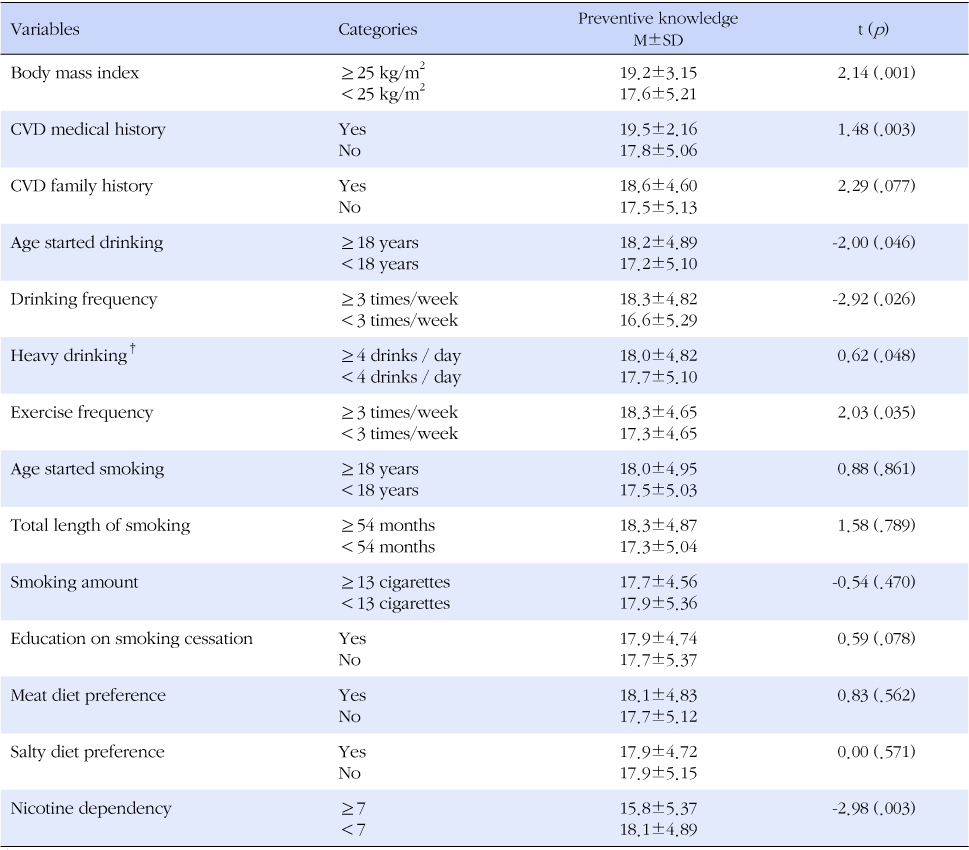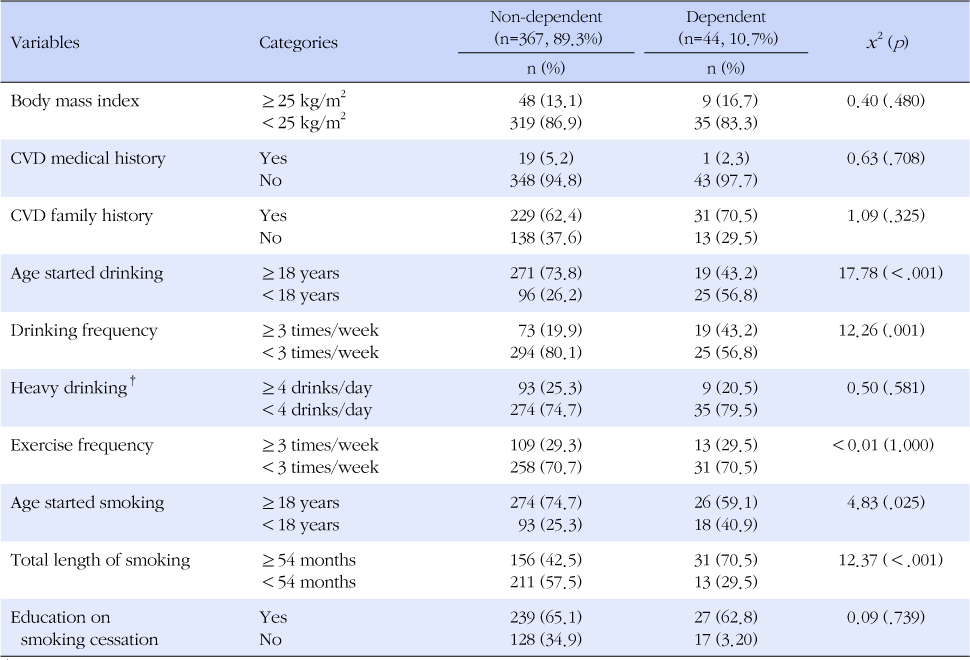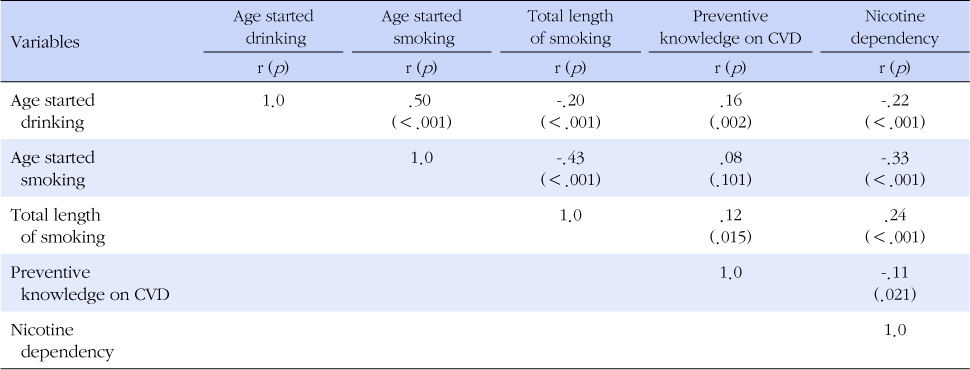Articles
- Page Path
- HOME > J Korean Acad Community Health Nurs > Volume 25(2); 2014 > Article
-
Original Article
- Knowledge on Cardiovascular Prevention and Nicotine Dependency among Smoking Male College Students
- Seon Young Hwang, Kyongok Park
-
Journal of Korean Academy of Community Health Nursing 2014;25(2):75-84.
DOI: https://doi.org/10.12799/jkachn.2014.25.2.75
Published online: June 30, 2014
1Department of Nursing, Hanyang University, Seoul, Korea.
2Department of Nursing, Far East University, Eumseong, Korea.
© 2014 Korean Academy of Community Health Nursing
This is an Open Access article distributed under the terms of the Creative Commons Attribution Non-Commercial License (http://creativecommons.org/licenses/by-nc/3.0/) which permits unrestricted non-commercial use, distribution, and reproduction in any medium, provided the original work is properly cited.
- 628 Views
- 4 Download
- 3 Crossref
Abstract
-
Purpose
- This study aimed to identify the level of knowledge on preventing cardiovascular disease (CVD) and nicotine dependency among smoking male college students, and to examine the predicting factors of nicotine dependency.
-
Methods
- This study was conducted as cross-sectional descriptive research using structured questionnaires. Data were collected from 411 smoking male college students (22.5±2.59 yr) at two universities located in two cities in Korea from September 2012 to April 2013. Logistic regression analysis was performed to estimate age-adjusted odds ratios of nicotine dependency.
-
Results
- The mean value of nicotine dependency was 4.2±1.96 and the percentage of participants who had strong nicotine dependency (≥7) was 10.7%. Logistic regression analysis showed that, when adjustment was made for age, nicotine dependency was predicted by the frequency of alcohol drinking (≥3 times/week), knowledge on CVD prevention, the age starting drinking, and the total length of smoking.
-
Conclusion
- Nicotine dependency was strongly related to the frequency of drinking alcohol and lower knowledge on CVD prevention. Therefore, male college students who have a dependent smoking habit and drink alcohol frequently need to take more interest in health through educational counseling to modify their lifestyle behaviors and to have preventive knowledge related to CVD.

†CVD Medical history included hypertension, dyslipidemia, or diabetes current or in the past; Multiple responses allowed; ‡Family CVD history included hypertension, dyslipidemia, or diabetes having among the family members; Multiple responses allowed; §Heavy drinking was defined≥4 drinks/day or≥14 drinks/week.
- 1. Korea National Statistical Office. Korea national health assessment nutritional examination survey in 2007-2010 [Internet] Seoul: Statistics Korea; 2011;cited 2013 April 30. Available from: http://knhanes.cdc.go.kr/knhanes/index.do
- 2. Shin SR, Linda S, Leda D. Tobacco-related education in graduate, baccalaureate and associate degree programs in Korea. J Korean Acad Nurs. 2003;33(2):256–264. ArticlePubMedPDF
- 3. Lee KH, Jeong MH, Ahn YK, Kim JH, Chae SC, Kim YJ, et al. Sex differences of the clinical characteristics and early management in the Korea acute myocardial infarction registry. Korean Circ J. 2007;37(2):64–71. Article
- 4. Cho JY, Jeong MH, Ahn Y, Chae SC, Seong IH, Kim YJ, et al. Predictive factors of major adverse cardiac events and clinical outcomes of acute myocardial infarction in young Korean patients. Korean Circ J. 2008;38(3):161–169. Article
- 5. Rhim KH, Lee JH, Choi MK, Kim CJ. A study of the correlation between college students' drinking and smoking habits. Korean Public Health Res. 2004;30(1):57–70.
- 6. Grundy SM, Pasternak R, Greenland P, Smith S Jr, Fuster V. Assessment of cardiovascular risk by use of multiple-risk-factor assessment equations: A statement for healthcare professionals from the american heart association and the american college of cardiology. Circulation. 1999;100(13):1481–1492. ArticlePubMed
- 7. Colder CR, Lloyd-Richardson EE, Flaherty BP, Hedeker D, Segawa E, Flay BR, et al. The natural history of college smoking: Trajectories of daily smoking during the freshmen year. Addict Behav. 2006;31(12):2212–2222. PubMed
- 8. Fagerstrom KO, Schneider NG. Measuring nicotine dependence: A review of the Fagerstrom tolerance questionaire. J Behav Med. 1989;12(2):159–182. ArticlePubMedPDF
- 9. Seo YS, Yoon HJ, Kwon JH, Lee SK. Smoking status and nicotine dependency of high school students in Daegu. J Korean Soc Sch Health. 2003;16(1):105–119.
- 10. Lee KJ, Chang CJ, Kim MS, Lee MH, Cho YH. Factors associated with success of smoking cessation during 6 months. J Korean Acad Nurs. 2006;36(5):742–750. ArticlePubMedPDF
- 11. Seo JM, Lee YM, Park NH, Jo YS, Kim JS, Hwang SK, et al. A study on smoking habits, nicotine dependency and self-efficacy corresponding to stage of change in smoking cessation in industrial workers. J Korean Acad Psychiatr Ment Health Nurs. 2002;11(4):538–547.
- 12. Kim EY, Hwang SY. Incidence risk of cardiocerebrovascular disease, preventive knowledge, stage of change and health behavior among male bus drivers. Korean J Adult Nurs. 2011;23(4):321–331.
- 13. Reed MB, Wang R, Shillington AM, Clapp JD, Lange JE. The relationship between alcohol use and cigarette smoking in a sample of undergraduate college students. Addict Behav. 2007;32(3):449–464. ArticlePubMed
- 14. Shin SJ. Case comparison study about cardiovascular disease's risk factor and life habit [master's thesis]. [Seoul]: Kyung Hee University; 2007. 76 p.
- 15. Choi OJ, Cho BH. The effect of supportive nursing care on the knowledge level and compliance of sick-role behavior of patients with coronary artery disease after coronary angiography. J Korean Acad Adult Nurs. 2007;19(5):729–738.
- 16. Moon ES, Jung HS, Choi ES. A study on soldiers' knowledge, attitude and health belief about AIDS. J Korean Community Nurs. 2004;15(2):298–307.
- 17. Shin YH, Chun YK, Cho SM, Cho YR. The effects of a sex education program on knowledge related to sexually transmitted diseases and sexual autonomy among university students. J Korean Acad Nurs. 2005;35(7):1304–1313. ArticlePubMedPDF
- 18. Waters K, Harris K, Hall S, Nazir N, Waigandt A. Characteristics of social smoking among college students. J Am Coll Health. 2006;55(3):133–139. ArticlePubMedPMC
- 19. Park SW. A review of cigarette smoking-related behaviors and health problems among university students. J Korean Soc Health Educ Promot. 2011;28(5):35–49.
- 20. National Institute Alcohol Abuse and Alcoholism. Alcohol screening and brief intervention for youth [Internet] Rockville: NIAAA Publication and Distribution Center; 2013;cited 2013 April 30. Available from: http://pubs.niaaa.nih.gov/publica tions/Practitioner/YouthGuide/YouthGuideOrderForm.htm
- 21. Park HJ. The effects of lifestyle modification education program on the workers' knowledge, attitude and behavior to prevent cerebrocardiovascular diseases in middle and small-sized industries [master's thesis]. [Seoul]: Dongguk University; 2008. 121 p.
- 22. Choi IH. Effect of an agreement on means to achieve smoking cessation goals among college student smokers. J Korean Acad Nurs. 2005;35(7):1362–1370. ArticlePubMedPDF
- 23. Bang HA, Rhim KH. The status of health education program and the needs of restriction on drinking and smoking. J Korean Soc Sch Health Educ. 2008;9(1):143–156.
- 24. Donovan JE. Adolescent alcohol initiation: A review of psychosocial risk factors. J Adolesc Health. 2004;35(6):529.e7–529.e18. ArticlePubMed
- 25. Dani JA, Harris RA. Nicotine addiction and comorbidity with alcohol abuse and mental illness. Nat Neurosci. 2005;8(11):1465–1470. ArticlePubMedPDF
- 26. Wetter DW, Kenford SL, Welsch SK, Smith SS, Fouladi RT, Fiore MC, et al. Prevalence and predictors of transitions in smoking behavior among college students. Health Psychol. 2004;23(2):168–177. ArticlePubMed
- 27. Choi GY, Lee KH, Choi GY. The state of college freshmen's smoking and the application of cessation programs. J Korean Acad Community Health Nurs. 2007;18(2):301–309.
- 28. Kim EY, Hwang SY. Development and evaluation of a small group-based cardiocerebrovascular disease prevention education program for male bus drivers. J Korean Acad Nurs. 2012;42(3):322–332. ArticlePubMed
Figure & Data
References
Citations

- Immediate effect of interscapular cupping on blood pressure, oxygen saturation, pulse rate and chest expansion in sedentary smoker students
Ali Mohamed Ali Ismail, Abdelrhman Ismail Abdelghany, Ahmed Mohamed Abdelhalim Elfahl
Journal of Complementary and Integrative Medicine.2021; 18(2): 391. CrossRef - Tobacco Related Knowledge Is Associated with Heaviness of Smoking Index (HSI) and Intention to Quit among Korean Smokers: Findings from 2016 ITC Korea Survey
Yoon-Jung Choi, Hong Gwan Seo, Yeol Kim, Eun young Kim, Geoffrey T Fong, Mi Yan, Pete Driezen
Journal of the Korean Society for Research on Nicotine and Tobacco.2018; 9(S1): S31. CrossRef - Effects of diaphragm respiration exercise on pulmonary function of male smokers in their twenties
KyoChul Seo, Seung Hwan Park, KwangYong Park
Journal of Physical Therapy Science.2015; 27(7): 2313. CrossRef

 KACHN
KACHN




 PubReader
PubReader Cite
Cite

